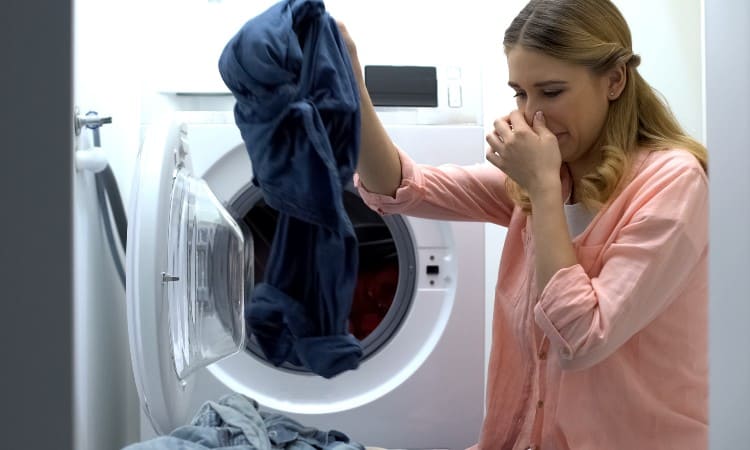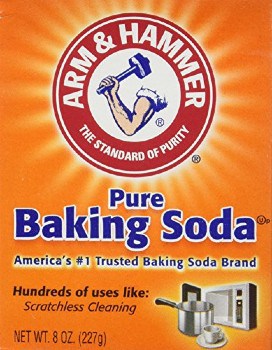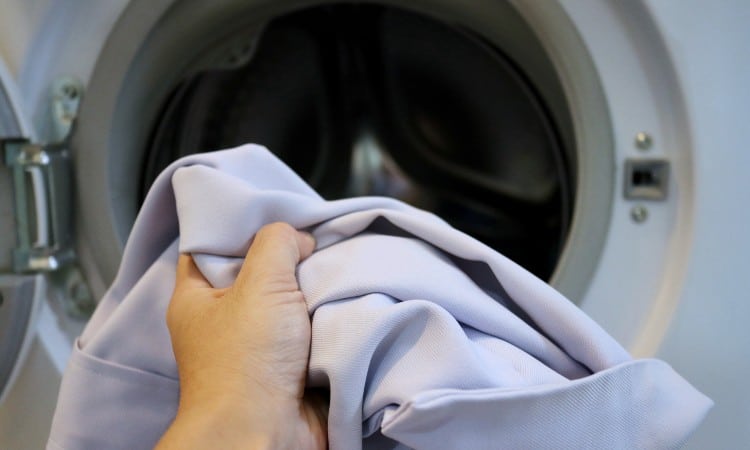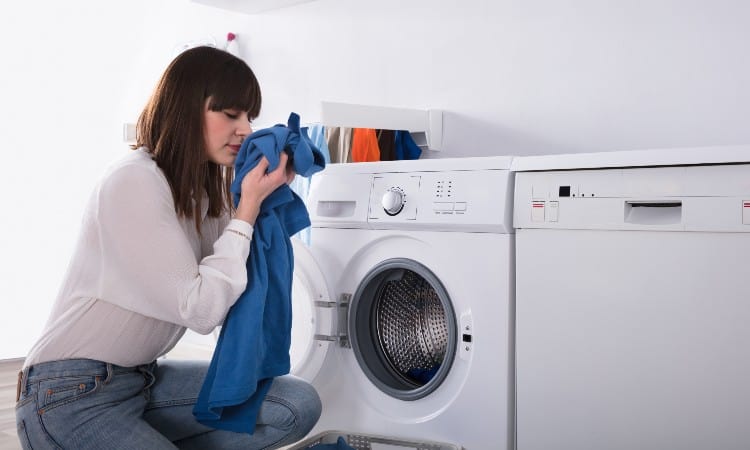One of the best feelings is pulling the laundry from the dryer and smelling the scent of the freshly washed clothes. But when you remove the clothes – thinking they’re so fresh and so clean – and get a whiff of stale, sour mildew instead – the feeling is the complete opposite. You’d think there’s no way a load of laundry coming straight from the dryer could smell so terrible, but we’ve all been there. If you find your clothes aren’t smelling fresh – even after washing – read on to learn how to get the sour smell out of clothes.
Adding baking soda and/or vinegar to the washing machine during the wash or rinse cycle are two of the best ways to eliminate sour smells from your clothes. It is also possible that the washing machine is the root cause of foul-smelling laundry. Giving the machine a thorough scrub can help stop bad smelling clothes as well.
In this article, we will go over the sources of sour-smelling laundry and three easy methods to get rid of them. We will also cover several ways that you can help prevent bad-smelling laundry in the first place – including detailed instructions on how to clean your washing machine, whether it’s front or top loading.

Quick Navigation
- How to Get the Sour Smell Out of Clothes
- Why Do My Clothes Smell Sour After Washing and Drying?
- 1. The Clothes Sat Wet Too Long Before Drying
- 2. The Laundry Load Was Too Big/The Machine Was Overfilled
- 3. Laundry Detergent Buildup
- 4. Fabric Softener Buildup
- 5. Damp Laundry in the Hamper
- 6. Drying For Too Long – in Humid Climates
- 7. Clothes Were Put Away While Still Damp
- 8. The Washing Machine Itself – Especially High-Efficiency Models
- How to Prevent Clothes From Smelling Sour in the Future
- How to Clean Your Washing Machine: Step by Step Guide
- Tips for Keeping Your Washing Machines Fresh
- What Is the Best Method to Remove Sour Smells From Clothes?
How to Get the Sour Smell Out of Clothes
If you’re already stricken with sour-smelling laundry – there is still hope. You can try washing clothes in hot water – being sure to check care labels to ensure they won’t be damaged by the heat – which can kill some bacteria. Or – air drying clothes in the sun can also be a simple, effective way to eliminate mild odors.
If this is an instance of truly foul-smelling clothes, you may need something more powerful. Below you will find three simple methods for successfully getting the worst smells out of your clothes. Note: after using any of these methods, be sure to follow directly by removing the clothes from the washing machine and allowing them to dry thoroughly.
1. Baking Soda
 Baking soda is an invaluable tool for cleaning and deodorizing all around the house – and it’s no different in the laundry room. It works by neutralizing pH levels – eliminating odors and leaving things smelling fresh and clean. Baking soda is great for removing mildew smells from clothes and is a natural, non-toxic option – making it safe for even the youngest members of the family.
Baking soda is an invaluable tool for cleaning and deodorizing all around the house – and it’s no different in the laundry room. It works by neutralizing pH levels – eliminating odors and leaving things smelling fresh and clean. Baking soda is great for removing mildew smells from clothes and is a natural, non-toxic option – making it safe for even the youngest members of the family.
To deodorize sour-smelling laundry using baking soda:
Set the washing machine to the hottest water temperature allowable for the clothing, and add 1 cup of baking soda along with the detergent. Wash as normal – it’s as simple as that! Some folks like adding ½ cup of baking soda with their detergent for every wash to keep things fresh.
2. Vinegar
 Distilled white vinegar works miracles on foul-smelling laundry! Even though vinegar has a strong smell, this acidic substance neutralizes other odors and is extremely effective at removing and preventing mildew. An added bonus to using vinegar for your laundry is that it will dissolve built-up soap residue – leaving clothes feeling extra soft.
Distilled white vinegar works miracles on foul-smelling laundry! Even though vinegar has a strong smell, this acidic substance neutralizes other odors and is extremely effective at removing and preventing mildew. An added bonus to using vinegar for your laundry is that it will dissolve built-up soap residue – leaving clothes feeling extra soft.
To eliminate the sour smell from clothes using vinegar:
Set the machine to the hottest water temperature allowable for the clothing. Add 1 cup of distilled white vinegar – no need to add detergent. The vinegar will do all the work! If your smelly clothes are beyond foul – add a second cup of vinegar to the machine during the last rinse cycle. This should eliminate even the worst odors – and no, it won’t leave the clothes smelling like vinegar.
A half cup of vinegar can be added to every load of laundry to keep all of your clothes super fresh – as well as keep the machine clean and happy.
3. Borax
 Borax is a bit stronger than baking soda – but is still an all-natural product. Borax works by absorbing odors and stains and can even kill mold – making it a great tool in the laundry room.
Borax is a bit stronger than baking soda – but is still an all-natural product. Borax works by absorbing odors and stains and can even kill mold – making it a great tool in the laundry room.
To get rid of sour smells in clothes with borax:
Add ½ cup of borax to the washing machine before putting in the clothes. Wash as normal, according to clothing care labels. A pre-soak solution can also be used. To deodorize clothes using borax: use ¼ cup of borax per 1 gallon of water – mixing enough of the solution so that the clothing will be fully submerged. Soak the clothes for at least 30 minutes – followed by washing as usual.
As with baking soda and vinegar – borax is often used as an additive with regular laundering. Half a cup sprinkled into the machine before each load will help keep clothes looking bright and smelling great.
Why Do My Clothes Smell Sour After Washing and Drying?

What is worse than doing all the work to sort, wash, and dry the laundry just to have it come out smelling worse?! It seems counterintuitive – and even nearly impossible – that clothes that have just been washed can smell SO bad. Mildew and mold are the most common culprits of sour-smelling clothes.
This fungus develops easily when clothes are left to sit in damp, dark, and warm environments. This can occur in the hamper or the drum of the washing machine – both ideal habitats for mildew growth. Bacteria not being thoroughly removed from dirty laundry – for one reason or another – is another common reason your clothes may be smelly. Below you will find eight specific causes for laundry smelling sour, along with helpful hints on how to prevent it in the future.
1. The Clothes Sat Wet Too Long Before Drying
Even with the best intentions, life gets busy and laundry gets forgotten in the washing machine. Sometimes even after a few hours, laundry sitting wet after washing can develop mildew – and therefore, a sour smell. The inside of a washing machine that just finished a cycle is the perfect environment for mold.
Being dark and enclosed means moisture and warmth are trapped inside and there is no way for air to flow through. If you can get your clothes into the dryer immediately following the wash cycle, you eliminate one common source of sour-smelling laundry.
Once in the dryer – use the highest heat setting allowable for your clothing. Using a very low setting can keep clothes damp for quite a while in the dryer, increasing the risk of smelling like mildew. A hotter drying temp will ensure that the clothes dry quickly and thoroughly.
2. The Laundry Load Was Too Big/The Machine Was Overfilled
Finding someone who adores doing laundry is a rarity, so it’s understandable if you try to fit as much into one load as possible to get the job done quicker. Unfortunately, overloading the washing machine is another way you may be encouraging foul-smelling clothes – ultimately drawing out the chore even longer.
If you put too many clothes in the washing machine, there isn’t enough space for them to move around when agitated. This means that soap and water can’t get to the dirt and grime on clothes nor rinse it all away. Overloaded machines rarely get clothes fully clean, leaving bacteria – and anything smelly – behind.
To make sure that your machine is doing the most efficient job possible, wash in smaller loads and make sure that the water setting is high enough that clothes will be thoroughly soaked and rinsed. One trick for high-efficiency machines – which use much less water – is to throw a water-soaked towel into the machine at the start of the cycle. The additional weight of the towel will lead the machine to believe that the load is bigger than it actually is – using a higher water-to-clothing ratio for washing and rinsing.
3. Laundry Detergent Buildup
You’d think adding more detergent to a load of laundry would do a better job of cleaning, right? The truth is the opposite. All laundry detergents are highly concentrated. To the naked eye, it may not appear as if you’re adding much soap to the machine – but once mixed with water – a little goes a long way.
If you increase the amount of laundry detergent you use, rinsing becomes more difficult. If detergent isn’t completely rinsed from each load of laundry – especially over time – build-up will occur. This can happen both on your clothes and in the machine. Laundry detergent built up in a washing machine encourages mold to grow – the main culprit for sour-smelling laundry.
Go against your instincts when you’re inclined to add a splash more detergent to the load. Your clothes will end up cleaner, and you’ll save on detergent – thanking yourself in the long run. Pro-tip: Liquid laundry detergents cause more buildup, especially in high-efficiency machines. To give yourself another leg up – opt for powdered laundry detergent.
4. Fabric Softener Buildup
Everyone loves soft laundry! But in terms of the well-being of both your clothes and your machine – fabric softener shouldn’t be used with every load (especially when washing towels!) A fabric softener is an oil-based substance that is added to the rinse cycle to combat static cling.
Fabric softener – having a hydrophobic chemical makeup – can easily build up in washing machines and on fabric. So, while it may smell great in the beginning – fabric softener buildup leaves behind an environment that is even more conducive to the mold growth that results in stinky clothes. Not to mention the slew of questionable and potentially toxic ingredients that many fabric softeners include.
Instead of relying on a commercial fabric softener – try using wool balls in the dryer to eliminate static. You can purchase them specifically for this purpose or make them into a DIY project! Tennis balls and aluminum foil can have similar effects if you don’t want to make the additional effort. Alternatively, try adding a ½ cup of vinegar to the rinse cycle for clothes that come out nice and soft. Spoiler alert – vinegar is also a master at ridding clothes of undesirable odors.
5. Damp Laundry in the Hamper
Never put a wet item into the hamper! One wet towel, or swimsuit that wasn’t allowed to dry, thrown into a hamper of dirty clothes can make the whole basket reek. Mildew will thrive in the moist, dark environment at the bottom of the hamper, resulting in smelly clothes. Even after going through a normal wash cycle, it is likely that these clothes will still smell and will need to be washed again.
To make things easier on yourself – and skip the hassle of having to rewash an entire load – allow any wet items, or even damp, to thoroughly dry before adding them to the bin. Don’t forget about workout clothes! Soaked in already unpleasant smelling sweat – bacteria can start breeding within hours – increasing bad smells exponentially.
6. Drying For Too Long – in Humid Climates
It may come as a surprise, but drying clothes for too long can take them past the point of dry and back into dampness. This is more often a problem in humid climates. Once the machine has done its job and the clothing becomes dry – if it continues to run – the dryer can begin to pull in outside air.
If you happen to live where humidity is high, this means moisture is being reintroduced to the clothes – redampening them. If the clothes are damp for too long, they may develop mildew and that musty, sour smell.
Whenever possible – stop the dryer as soon as clothes are completely dry and remove them from the dryer.
7. Clothes Were Put Away While Still Damp
If you put away your clothes in haste – before they were allowed to dry completely – you may regret it next time you want to wear a shirt from that load. It seems like an innocent mistake, but putting away laundry while it’s damp is never a good idea.
The laundry won’t necessarily smell bad yet, but clothes that are put away damp can easily fall prey to mildew. This is especially true for items that will be folded and stored in drawers. These sour-smelling clothes may come as a surprise when you want to wear them later – since you assumed everything was okay when they were put away.
To save yourself the extra work – and from scrambling to find a clean-smelling outfit – make sure all laundry is thoroughly dry before putting it away. This is an especially pertinent point in humid areas – where getting clothes totally dry can already be a challenge.
8. The Washing Machine Itself – Especially High-Efficiency Models
Like most people, you probably aren’t cleaning your washing machine weekly. But if sour-smelling clothes have become a frequent problem and you’re doing everything else right – it’s probably time to give the machine some attention. Like any other appliance, washing machines need routine maintenance to keep them running smoothly. A machine that uses water and other liquid substances is a breeding ground for mold, mildew, and bacteria – all things that smell bad.
Once you’ve given your washing machine a proper cleaning – and follow the guidelines above – sour-smelling laundry should be a thing of the past.
How to Prevent Clothes From Smelling Sour in the Future

Prevention is often a much easier solution than finding a remedy for a problem. Following these simple steps will help ensure that your clothes and towels are always fresh, clean and smell great:
- Wash laundry in small loads.
- Do not use more detergent than recommended. Ever.
- Skip the fabric softener – instead, opt for a vinegar rinse or wool dryer balls.
- Don’t put anything damp in your hamper.
- Allow clothes to dry thoroughly before putting them away to be stored.
- Clean your washing machine routinely – run a hot cycle with vinegar several times a year, and do a deep clean once every six months.
How to Clean Your Washing Machine: Step by Step Guide
Your washing machine cleans clothes several times a week – but if you’ve never cleaned your washing machine – you’re not alone. Washing machines often get neglected because it is assumed that they practically clean themselves. But, to keep things running smoothly – and smelling nice – every washing machine should be thoroughly cleaned at least once a year – ideally every six months. Below you will find details on how to clean both top and front loading machines.
Top Load Washing Machine
To clean a top-loading washing machine, follow these steps:
1. Soak with Vinegar
Set the machine to its hottest temperature and highest water level settings. Add 4 cups of vinegar to the drum and press start. Once the machine is done filling with water and it is just beginning to agitate – pause the cycle and allow the vinegar and water to sit for 1 hour.
2. Wipe Down the Machine
While the inside is soaking – thoroughly wipe down the rest of the machine using vinegar sprayed onto a microfiber cloth. Make sure to get around the rim of the lid – where gunk can get stuck and hide. Also, pay extra attention to the soap and fabric softener trays that can harbor buildup. Use an old toothbrush to scrub away extra hard-to-remove bits, if necessary.
3. Finish the cycle
After an hour, restart the cycle and allow it to run through.
4. Wash with Baking Soda
Keeping the settings the same as above – add 1 cup of baking soda to the machine and allow it to run its course.
5. Allow to Dry
It’s important that the machine is allowed to dry to keep mildew from developing immediately. Leave the lid open so air can flow through, allowing the machine to dry.
Front Load Washing Machine
A high efficiency front–loading machine is much more prone to buildup and may take a little more effort to scrub clean. But, if you keep up with maintenance – regular cleaning will be a breeze and your laundry will always smell great!
1. Clean the Drum
Spritz the entire interior of the washing drum and wipe clean with a microfiber cloth using distilled white vinegar in a spray bottle.
2. Clean the Gaskets
The rubber gaskets – which make up the seal around the door – are prime areas for grimy, smelly buildup! Using vinegar and a rag, clean all around the gaskets – getting rid of as much scum as possible.
3. Clean the Dispenser Trays
The other most scummy area is the detergent and fabric softener trays. Especially if you regularly use liquid detergent and fabric softener, this area can get gross. Clean every inch of these trays with vinegar and a rag – breaking out the old toothbrush if there is dried, stuck-on buildup.
4. Wash Cycle with Vinegar
Set the washer to run on its longest setting and at its highest temperature. Poor 2 cups of distilled white vinegar into the – newly cleaned! – detergent dispenser. Allow the washer to run through the cycle.
5. Wash Cycle with Baking Soda
With the same settings in place – pour ½ cup of baking soda directly into the drum of the washing machine, press start, and allow it to run through the entire cycle.
6. Wipe Down the Machine
While the machine is running – or once it has finished – wipe down the rest of the exterior using the vinegar spray and microfiber towel – preferably not the same towel used to clean the gaskets.
7. Allow to Dry
Leave the door ajar and allow the machine to air dry. You can use a dry towel to expedite the process – particularly around the gaskets, where water is prone to get trapped.
Tips for Keeping Your Washing Machines Fresh
Cleaning the washing machine takes a bit of time and effort, but it’s an important – and satisfying – chore. Keeping your washing machine mold and mildew-free will help make sure your clothes are truly clean when they come out. To make things easier on yourself when it’s time for the semi-annual deep clean, make sure to do the following regularly:
- Don’t overload the machine.
- Don’t use too much detergent.
- Choose powdered detergent rather than liquid.
- Forgo the fabric softener.
- Leave the door ajar after each use – allowing the machine to dry.
- Open dispenser trays after each wash – wipe down or allow to air dry.
- Deep clean every six months.
- Use a washing machine cleaner – such as Affresh – every month or so between deep cleaning.
What Is the Best Method to Remove Sour Smells From Clothes?
Sour-smelling laundry is an affront to the nose and can be off-putting to those around us. Thankfully, there are several simple methods you can use to rid clothes of these offensive, rancid smells – the easiest and most effective being a simple wash with vinegar.
Vinegar will not only rid clothes of bad odors – it has the added benefit of softening, brightening, and eliminating static cling. If you don’t have a gallon of white vinegar in your cupboard right now – you should probably get some immediately! And add “getting sour smells out of clothes” to its list of positive uses.